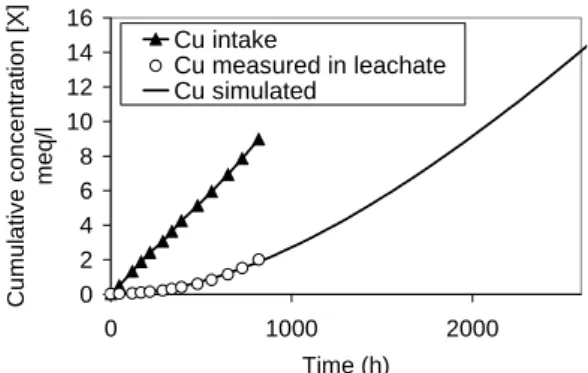HAL Id: hal-00090323
https://hal-insu.archives-ouvertes.fr/hal-00090323
Submitted on 30 Aug 2006HAL is a multi-disciplinary open access archive for the deposit and dissemination of sci-entific research documents, whether they are pub-lished or not. The documents may come from teaching and research institutions in France or abroad, or from public or private research centers.
L’archive ouverte pluridisciplinaire HAL, est destinée au dépôt et à la diffusion de documents scientifiques de niveau recherche, publiés ou non, émanant des établissements d’enseignement et de recherche français ou étrangers, des laboratoires publics ou privés.
A Pollutant transport investigated through an expansive
clay
Chantal Proust, Lydie Le Forestier
To cite this version:
Chantal Proust, Lydie Le Forestier. A Pollutant transport investigated through an expansive clay. 2nd Mid-European Clay Conference, 2004, Miskolc, Hungary. �hal-00090323�
Mecc’04
2nd Mid-European Clay Conference 20-24 september 2004 , Miskolc, Hungary
A Pollutant transport investigated through an expansive
clay
PROUST, C., LE FORESTIER, L., (Polytech’Orléans, - ISTO (UMR 6113, CNRS-Université d’Orléans), 8 rue Léonard de Vinci, 45 072 Orléans cedex 2, France, JULLIEN, A., (Laboratoire Central des Ponts et Chaussées, Route Bouaye, BP 4129, F- 44341 Bouguenais , and LEDEE, R., Polytech’Orléans,
E-mail : chantal.proust@univ-orleans.fr
In the framework of domestic waste disposals, the in-situ compaction of soil is usually used to obtain engineered clay barriers with suitable confining properties. Permeability and pollutant retention are the major properties which should be investigated in this context for barrier evaluation. Considering clay barriers in contact with waste leachates, they may be saturated by solutes of various chemical compositions, including in particular toxic heavy metals. In this context, the expansive Fo-Ca clay, a natural Ca-smectite from the Paris basin of Ypersian (Sparnacian) age, was chosen because of its very low permeability and ability for pollutant retention through cationic exchanges. The smectic is associated with kaolinite (up to 20%), and minor quartz, calcite, goethite and gypsum.
An experimental work (JULLIEN et al., 2002) was performed to analyse the Fo-Ca performances when submitted to chemo-hydro-mechanical coupled effects produced by soaking the clay with a polluted solute. For this purpose, tests were performed using 10-1 mol/l Cu(NO3)2 solution. The evolution of leachate chemical composition was carried out as a
function of time in order to characterise the ability of the clay to copper retention (fig 1). The previous studied clay samples can be considered as a system submitted to an external parameter (x(t)) and delivering a response to it (y(t)). The copper behaviour can be modelling with a like global equation 1.
x(t) = Bt y(t) = B (t-τ + τ e(-t/τ))
Intake copper flux Copper flux in leachate
where B is ∂M/∂t (with M is the molar concentration of the input copper solution (mol/L)), TL-1 is the Laplace transform, τ is the time constant (hour), and H the gain in the permanent regime.
Simulated curves using different copper concentrations are presented on figure 2. To validate this model, an experiment was carried out with a 0.5 mol/l Cu(NO3)2 solution. The
model allows to predict the behaviour of more dilute copper solution representative of waste leachate through a clay barrier.
TL-1H(s)
Or Clay
Mecc’04
2nd Mid-European Clay Conference 20-24 september 2004 , Miskolc, Hungary
0 2 4 6 8 10 12 14 16 0 1000 2000 Time (h) Cu m u la tiv e c o n c e n tr ati on [X] meq/ l Cu intake Cu measured in leachate Cu simulated
figure 1 : experimental concentrations of copper
0 2 4 6 8 10 0 500 1000 1500 2000 2500 Time (h) Cum u la ti ve con c en tr at io n [ X ] meq /l
calculated [Cu]=0.5 mol/l calculated [Cu]=0.1 mol/l calculated [Cu]=0.0545 mol/l calculated [Cu]=0.3 mol/l sample 0.1mol/l simulation [Cu]=0,2 mol/l sample [Cu]=0.2 mol/l
figure 2 : simulated curves of different copper concentrations
References
A. Jullien, C. Proust, L. Le Forestier, P. Baillif. "Hydro-Chemio-mechanical coupling effects on the properties of a Ca smectite." Applied Clay Science, 21, 143– 153 (2002)
